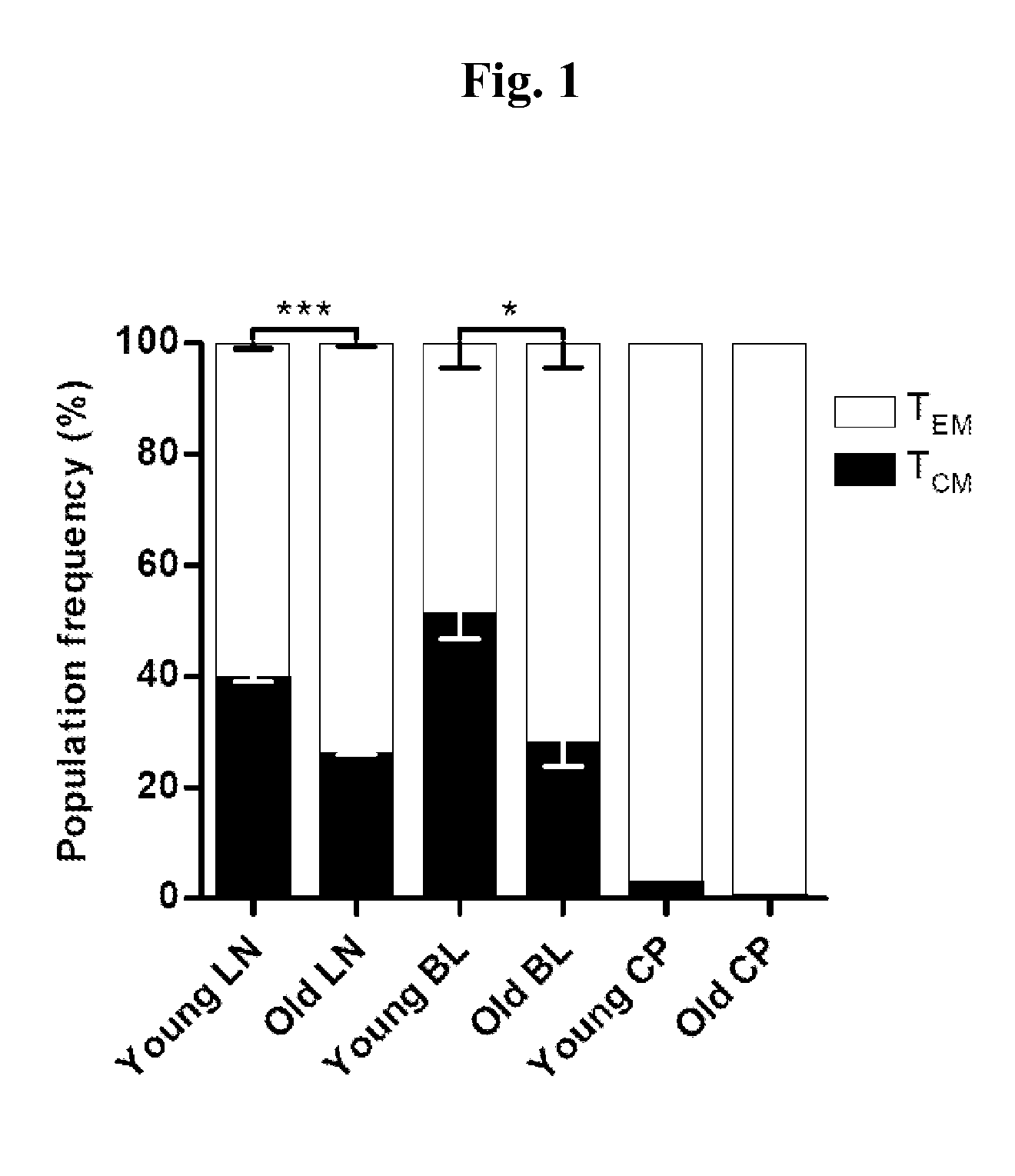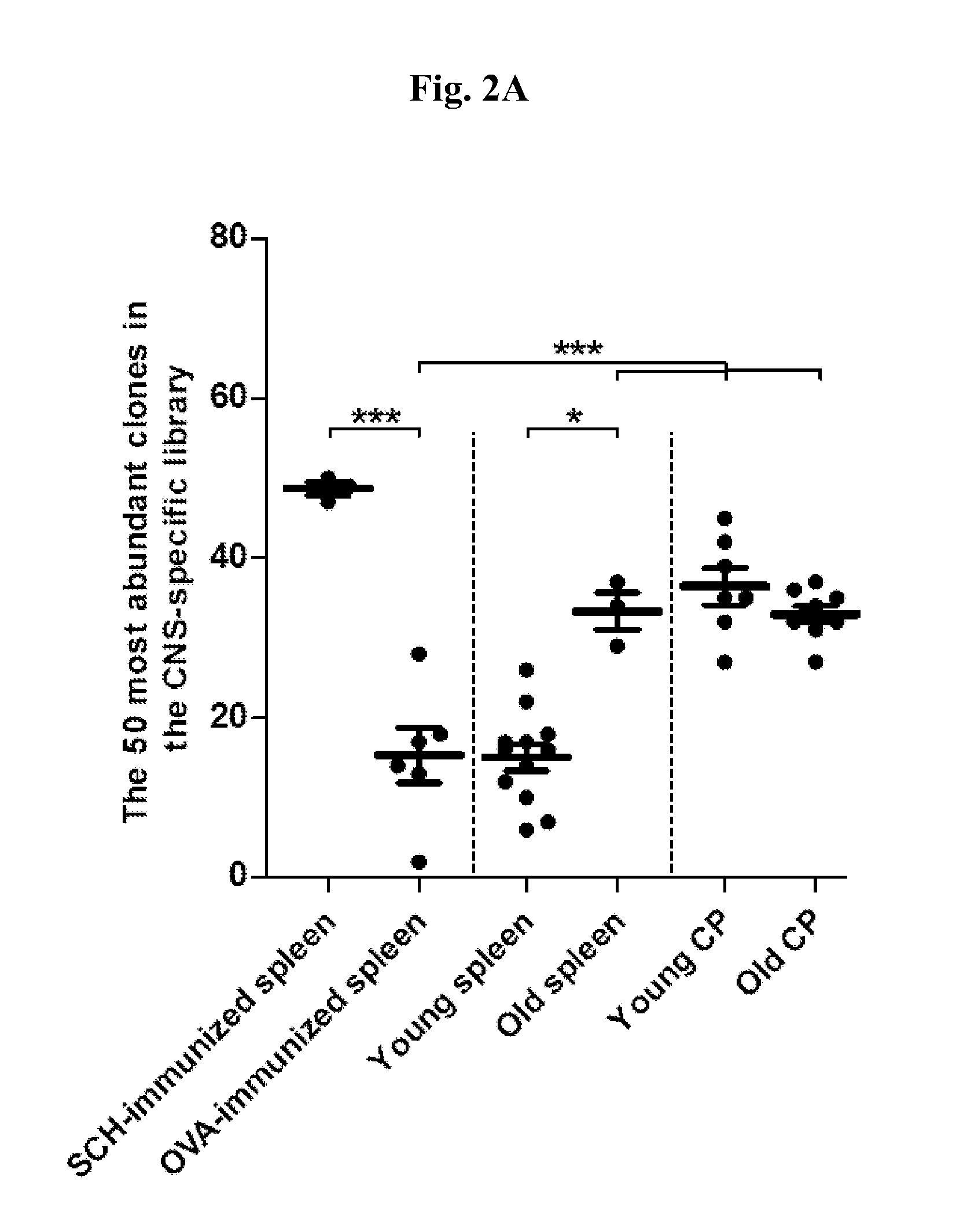Individualized immunomodulation therapy for neurodegenerative disorders, CNS injury and age-related dementia
a neurodegenerative disorder and immunomodulation therapy technology, applied in the field of neurodegenerative disorders, cns injury and age-related dementia, can solve the problems of insufficient improvement, general unsatisfactory treatment methods of cns disease, etc., and achieve the effect of reducing immunosuppression
- Summary
- Abstract
- Description
- Claims
- Application Information
AI Technical Summary
Benefits of technology
Problems solved by technology
Method used
Image
Examples
example 1
The Choroid Plexus is Populated by Effector Memory CD4+ T Cells
[0155]Using flow cytometry, we began by characterizing the T cell populations within the choroid plexus (CP). We found that, similarly to the lymph nodes, the majority (67±2.76%) of T cells found in the CPs were CD4+ cells (data not shown). Since CD4+ T cells (rather than CD8+ cells) were previously implicated in supporting CNS plasticity (Wolf S A, et al. (2009), Derecki N C, et al. (2010), Cao C, et al. (2009)) we further characterized this sub-population. We focused our interest on memory T cells, commonly divided into two subsets that express high levels of CD44, yet differ in their expression of CD62L; CD44high / CD62Lhigh are central memory T cells (TCM) that home to secondary lymphoid organs and generally have little to no effector function, while CD44high / CD62L− / low are effector memory T cells (TEM) that survey peripheral tissues, and can be locally activated to an immediate effector function upon exposure to their...
example 2
The Choroid Plexus CD4+ TCR Repertoire is Enriched with CNS-Specific Clones
[0156]Sequencing of the TCR by itself cannot identify its antigenic specificity. Therefore, to identify the specificity of the T cells that reside in the CP, we developed a novel tool that allowed us to identify clonotypic enrichment of CNS-specific T cells. To this end, we created a library representing the TCRP repertoire of CNS-specific antigens. Mice were immunized either with spinal cord homogenate (SCH), containing a wide array of CNS proteins, or, as a control, with a non-self peptide antigen derived from ovalbumin (OVA). After 7 days, RNA isolated from splenic CD4+ T cells of both groups of immunized mice, as well as from a group of non-immunized mice, was analyzed using TCR-seq, a high throughput sequencing procedure of the TCRP CDR3 region (Freeman J D et al. (2009); Robins H S, et al. (2009); Venturi V, et al. (2011)). We also used TCR-seq to analyze the TCRP repertoire of CP-residing T cells. Usin...
example 3
Th2-Mediated Inflammation of the CP Epithelium During the Aging Process
[0160]Our demonstration that the overall TCR specificity of the CD4+ T cells residing in the CP is maintained with age, led us to consider the possibility that aging of the CP may be associated not with changes in immune specificity, but rather with phenotype bias, such as changes in the cytokine milieu, a phenomenon established outside the CNS (Alberti S, et al. (2006); Shearer G M (1997); Rink L et al. (1998)). We therefore measured mRNA expression levels of the cytokines IFN-γ and IL-4 in the CP, representing Th1 and Th2 effector milieus, respectively. We found preferential elevation of IL-4 expression, and a decline in IFN-γ expression with aging (FIG. 3A). Outside the CNS, IL-4 was shown to induce the elevation of CCL11 (Bloemen K, et al. (2007)), a chemokine recently shown to play a part in age-related cognitive decline and to be elevated in the CSF and plasma of aged mice and humans (Villeda S A, et al. (2...
PUM
| Property | Measurement | Unit |
|---|---|---|
| latency time | aaaaa | aaaaa |
| real time qPCR | aaaaa | aaaaa |
| real time qPCR | aaaaa | aaaaa |
Abstract
Description
Claims
Application Information
 Login to View More
Login to View More - R&D
- Intellectual Property
- Life Sciences
- Materials
- Tech Scout
- Unparalleled Data Quality
- Higher Quality Content
- 60% Fewer Hallucinations
Browse by: Latest US Patents, China's latest patents, Technical Efficacy Thesaurus, Application Domain, Technology Topic, Popular Technical Reports.
© 2025 PatSnap. All rights reserved.Legal|Privacy policy|Modern Slavery Act Transparency Statement|Sitemap|About US| Contact US: help@patsnap.com



